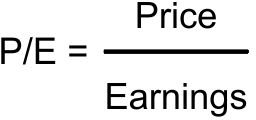Evaluating Market Value of Common Stock with Financial Ratios
Market Value of Comon Stock
Investors are constantly concerned with the market value of a share of stock. Perceptions that a stock is rising prompts the purchase of stock while perceptions of a fall in price prompts selling. Three major market value ratios are often used to determine whether buying or selling a stock is warranted. In all three, the market price per share is compared with relevant indicators of company profitability.
P/E Ratio
The Price to Earning ratio (P/E) is calculated by dividing the market price per share of a stock by the earnings per share. The market price is simply the current price for a stock selling on a stock exchange. The earnings per share can be calculated by dividing the total earnings of a company by the total number of shares of stock outstanding. The P/E ratio is calculated as:
P/E = Market Price per Share / Earnings per Share
When the P/E/ ratio is very high it indicates that recent buyers of the stock are speculating that profits sometime in the future will be high thereby justifying a high price per share. During the late 1990s when many dot com companies began trading on the stock exchanges, their P/E ratios went into the multiple-hundreds level.
This is because it was believed by investors that the Internet with its worldwide reach would make a company very profitable. The dot com bust soon after illustrated that the high risk of the dot com companies was in line with the expected return. Unfortunately for investors of the stock, the risk did not pay off and many dot com companies went bankrupt.
Earnings Yield Ratio
One of the problems with the P/E ratio is that the ratio can be negative when earnings are negative because earnings per share are in the denominator of the ratio. Also, when earnings are low, the P/E ratio can be very large. The Earnings Yield Ratio is simply the reciprocal of the P/E ratio. It can be calculated as:
Earnings Yield = Earnings per Share / Market Price per Share
Since the market price of a share of stock is rarely very small, it will not give negative or very small results. It is, however, more difficult to interpret than its reciprocal cousin, the P/E/ ratio. Still, it represents a more stable measure of market value and remains useful regardless of earnings figures.
Dividend Yield Ratio
The Dividend Yield Ratio is a comparison of the dividends per share paid to stockholders to the market price per share of stock. It is calculated as:
Dividend Yield = Dividend per Share / Market Price per Share
Like the Earnings Yield ratio, it is a stable measure of market value. The dividends paid to stockholders are a measure of expected income if shares of stock were owned. Of course, some companies have policies never to pay dividends, choosing to reinvest earnings into further operations. Unless a company pays regular dividends, this ratio is not useful as a measure of market value.
Conclusion
Valuing the price of a share of stock is a method of determining a company’s profitability. The principle of market efficiency states that all available information about a company is quickly represented in its price per share of stock. The market value ratios discussed here are quick glimpses into a company’s worth by assuming the market price per share is an accurate measure of future profitability.
Image Credit
Image: Author’s own creation
